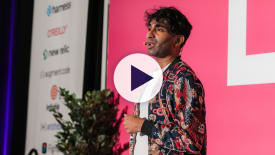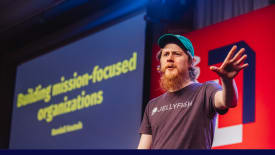
Latest videos
-

Target architecture – Align. Execute. Deliver.
Explore how defining a clear target architecture boosts alignment, speeds up execution, and scales teams through better decision-making.
-

Beyond sentiment: A practical framework for evaluating and growing the leaders who report to you
This talk offers a practical framework for evaluating and growing the people managers who report to you through impact, competencies, and systems.
-

“Us vs. Them” thinking
Why us vs. them thinking arises, how to spot it, and how – and why – to bridge the divide.
-

3 data-backed ideas to deter AI code quality problems
Learn what 250 million+ lines of code reveal about AI’s impact on code quality and how to address it.
-

Supply chain: Data infrastructure pipeline
Discover how modern data pipelines transform supply chains, enabling real-time insights, improving data quality, and optimizing logistics through advanced analytics.
-

Beyond the code: Leading engineering teams in the GenAI era
Explore how engineering leaders can guide teams through GenAI’s rise by focusing on the critical human work AI can’t replace.
-

No One Left Behind: Inside the Largest Domain Migration
A look at the industry’s most complex domain transfer, managed under pressure without losing a single team member.
Highlights from our conferences

Measure for Change
Picking metrics is one thing. But the harder decisions lie in what to do with them afterward.
View all videos from LeadDev London

Drive product gaps as an engineering leader
Discover practical strategies for engineering leaders to influence product development effectively, even in the absence of strong product management and a clear company vision.
view all videos from LeadDev NEW YORK

Growth in a downturn
In this talk, Smruti Patel asks, if hyper-growth is marked by spending more to make more, what does building for enduring growth look like?
view all videos from LeadDev berlin

Idea to Innovation
Join me as we embark on a journey to dissect the anatomy of innovation, uncover strategies to unlock the full potential of ideas, and transform them into impactful realities. Let’s build a strong culture of innovation, and make sure that it is not just a buzzword but a tangible outcome.
view all videos from staffplus london

Slack enterprise key management: Senior to staff lessons
Explore the key lessons and skills Audrei gained during their first Staff+ project, Slack Enterprise Key Management. This talk offers insights for anyone growing in their Staff+ career.
view all videos from staffplus NEW YORK
All videos
-

Lower your stress and your team’s stress by being ready for turnover
John Young covers specific, actionable strategies to prepare for turnover – roles and responsibilities, documentation practices, anti-patterns to avoid, and even “chaos monkey” style games – that you can use immediately to make life better both for you and for your team.
-

Combating the confidence gap: Case studies in tech recruiting
Maryam Jahanshahi discusses how studies of the confidence gap impact candidate pools based on millions of recruiting outcomes, describing three specific contexts where we’ve seen the confidence gap manifest.
-

What is tech policy and how you can get involved
Erica Greene discusses some of the big ongoing tech policy debates and walks through ways you can get involved in the policy world.
-

Technical Vision vs. Technical Strategy: The difference and why it matters
Jonathan Maltz digs into the nuts and bolts of setting a successful technical strategy. Startin by talking about the difference between technical vision and technical strategy.
-

Behind the curtain: Two sides of senior leadership
Leemay Nassery and Emily Samuels give you two perspectives! They share their experiences and challenges from both sides of the senior leadership coin: staff+ and senior management.
-

Scaling yourself: Increasing your scope and impact as an engineering manager (without just working harder)
Alex Peattie talks about how to spend your most precious resource as an engineering manager: your time.
-

Are we building engineering platforms using the right metrics?
Simone Casciaroli shares the HEAT metrics created while working at Babylon, how they helped create a successful Platform Product, what essential product decisions you need to make to help other teams strive and how they fit with other engineering metrics like DORA.
-

Using a learning-themed retrospective to strengthen your team’s learning culture and reduce learning debt
Kristen Foster-Marks shares her experience of leading a learning-themed retrospective, which encouraged her team to reflect on their personal beliefs about learning and up-skilling, their team’s learning culture, and the ways in which these beliefs and culture can both encourage and discourage engagement in on-the-job learning and up-skilling activities.
-

How to kill your team’s product
Elliot Sanchez shares how the mistakes made early in his career as a manager helped prepare him to handle a terrible situation in a way that stayed consistent with our values and got the members of his team to the best, most empathetic outcome we could hope for.
-

Setting up your team for success during your extended absence
Nisarga Markandaiah shares the things you can do to ensure success for your team while you are away, as more and more companies offer longer than before parental leaves or sabbaticals.
-

Security from scratch
Eleanor Saitta tells you as much as possible in 30 minutes about what you do need to worry about, when you need to worry about it, how you can fix it, and what you don’t need to worry about — yet.
-

Building healthier mission-focused organizations
Randall Koutnik talks about the three main categories of communication — pathological, bureaucratic and generative — and the important role they each play in a company’s success and failure.
-

Enabling the motivated: Facilitating role switches smoothly
Ben Clayman describes how an engineering lead can identify prospective team members, enable them to gain experience in the proposed role, and ultimately make the switch.
-

The (updated) story of why we migrate to gRPC and how we go about it
Matthias Grüter addresses technical discussions of advanced gRPC concepts such as interceptors, load balancing, and traffic management and how they are essential in large distributed systems.
-

Good technical debt
Jon Thornton discusses how this framework was used to rapidly build and ship Squarespace’s Email Campaigns product in less than 15 months. Along the way, you’ll get several practical guidelines for how tech debt can supercharge your technical investments.
-

How successful hackathons increase belonging, decrease anxiety and help people imagine new identities in tech
Dr Carol Lee shares an example of a successful internal hackathon at Pluralsight and how it impacts developer experience.
-

Strategies for cloud migration
Constantinos Svendinoglou talks about the Data Group at Squarespace which has been on a transformational journey to migrate our systems to the cloud. At the beginning of 2022, we were running entirely on our own hardware; but by the end of 2023 we expect to be 100% cloud native. This talk will cover the strategy, tactics and execution that went into effect to make the migration to being cloud native over possible.
-

Resilient Management: Lara Hogan in conversation
Resilient Management is a guide to building, inspiring and leading resilient teams
-

Leading with vulnerability: A practical guide
Christina Chan shares her personal journey with vulnerability, as she learned to reframe her discomfort as opportunities for growth and eventually find the courage to be vulnerable.
-

Building koi pond: simulating millions of slack clients
Join Maude Lemaire for a roller coaster ride of a story and a thrilling live demo of what Slack’s load testing systems can do!
-

Say no to burnout and stand up for yourself
Krys Flores reminds us of how to keep yourself in focus while still delivering value. Krys also includes examples of how you can bring yourself back to a place of focus when you feel your organization is trying its best to have you do-all-the-things.
-

How to complain positively
Josh Goldberg, a serial complainer with a catchy smile, will walk you through the steps he takes to make sure his complaining is heard and felt without causing pain.
-

Building effective relationships
Mike McQuaid discusses the three types of relationships critical to cultivate: mentor, mentee and peer, how to decide which relationships to invest in vs move on from, how to use these relationships to improve your career, your success and work and build up everyone surrounding you and how to still do this when remote or timezone separated from your coworkers.
-

Embedding on teams as a staff+ individual contributor
Shweta Bhandare shares her learnings with the process of embedding broken down into stages. For each stage, she will describe the focus areas, key relationships to build and nurture, outcomes to anticipate and finally how to unembed, making the team self-sufficient and self-confident in their ability to deliver.